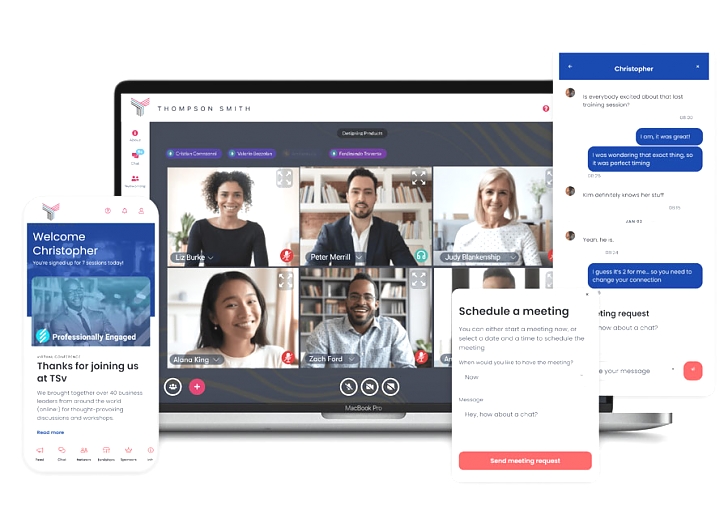
These days, you can find virtual events no matter what device and platform you use. Data shows that the future heavily involves remote participation. Here are the key developments in the digital event landscape that show how virtual events will only get bigger in 2022.
Live Streaming Virtual Events Is On The Rise

Live streaming has a “can’t miss” factor that taps into people’s FOMO (fear of missing out). According to Marketing Profs, Facebook users comment ten times more on live videos than on regular videos. Other social media networks like Instagram, Twitter, and YouTube, are close behind.
Over 80% of poll respondents favor a good quality livestream to a company’s blog or social media post. So, we can safely say that compelling live feeds like discussions, webinars, virtual product launches, and tutorials will take center stage in 2022. According to Cisco, 82% of all internet traffic by 2022 will involve video consumption.
With most social media networks having announced their “Happening Now” feature, it’s almost mandatory for marketers to broadcast some aspect of a corporate event onto the company’s social media accounts to generate buzz when the event is in progress. These changes have led to many companies opting for hybrid events to entertain remote audiences at trade shows and conferences, with others switching purely to virtual fairs for corporate events.
P2P Virtual Campaigns Are Picking Up Momentum

Only until a few years ago, nobody would have thought that a peer-to-peer fundraiser could be conducted virtually. People coming together to run a marathon or ride their bicycles across the city for charity is such a communal activity, and it wasn’t plausible that a DIY approach would deliver the same results here.
Come 2022 and even that has changed. With the growing popularity of wearable fitness tracking devices, it has become a lot simpler for nonprofits to arrange P2P campaigns for supporters where they virtually participate in their own time, from wherever they may be. Virtual P2P campaigns have proven their worth quite well.
Sensing this trend, many software companies are beginning to invest in the development of peer-to-peer fundraising applications that sync with wearable fitness trackers and enable users to raise funds based on how far they run or ride, the number of steps they take, or the number of calories they burn.
Other companies are developing similar technology that makes it possible for fitness-minded participants to build their own DIY campaigns or participate in virtual activities that are organized by nonprofits. With these virtual P2P events, organizations can deliver on the sense of community that drives the campaigns while allowing millennials and remote supporters to participate at their convenience.
Marketers Are Getting Serious About Attendee Tracking

Tracking attendees has been a hot topic of discussion in the event tech industry for several years. With virtual events, you can track leads, measure event performance, and gauge event ROI down to the most basic statistics.
For 2022, attendee tracking at events will hit fifth gear. This is because of the decreasing costs of using RFID/NFC and the continued rise of on-demand content. These virtual event tools help track event attendance, visitor traffic patterns, and engagement levels. In addition, they provide statistics you can translate into ROI.
Hyper-Personalization Is Becoming The Norm

Event marketers will continue to hone in on providing a customized experience to event attendees. This will particularly play out in post-event follow-ups, where companies send personalized content to their visitors based on their interests collected at the event. Since executive reports from the event can show which user engaged with what content at the event, it becomes easy to share relevant material with them during a follow-up.
As this follow-up strategy furnishes higher value call-to-actions — given that the material is relevant to the audience — they will be relied on heavily. While tracking behavior during the virtual event is one possibility, event hosts can also conduct polls and surveys, and capture detailed information at registration to gather enough insights about their attendees for a customized follow-up strategy.
Hybrid Events Are On The Rise
Things have started reopening and normalizing again. In addition, people are working out ways to adapt to the new normal and still have the experiences they want. When this reopening first happened, hosts realized that they needed to cater to both physical and online audiences. So, organizers will hsot part of their events and talks in person, and reach out to a wider audience with a virtual event element in 2022.
This trend will ensure that people are getting the best of both worlds. In addition, there will be less logistics and travel issues. Therefore, hybrid events will probably be the next big thing.
What’s Next With Virtual Events?
For event managers, the continuing growth of virtual events creates new ways of connecting with larger audiences. A recent survey found that 67 percent of respondents expected to leverage technology for events in the next three years.
However, making the most of this trend is not as easy as going live on Facebook for your regular event. Truly engage audiences in the highly competitive digital landscape of today. To do this, you should deliver a top-notch virtual event experience geared towards value addition.In addition, thingas are normalizing and people want to move back to partially physical spaces. This is where hybrid events come in. These events combine the best of both physical and virtual events. So, you can cater to a wider audience. Whether people want to attend physically or online, there are options.

